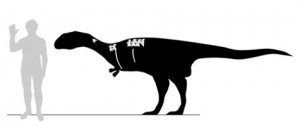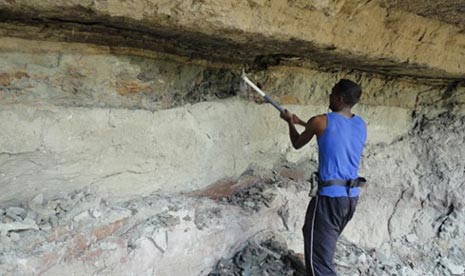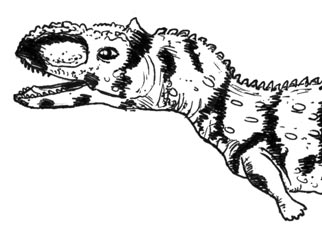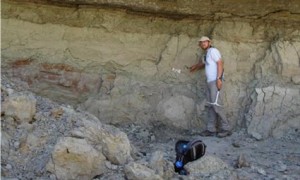“Lonely Small Bandit” Confirms Hypothesis that Abelisaurid Fossils were Awaiting Discovery
The United States, Canada and possibly Mexico may be able to lay claim as being the home of Tyrannosaurus rex but the island of Madagascar can take ownership of another short-armed Cretaceous terror, with the announcement of the discovery of a new genus of abelisaurid. Although, very fragmentary and consisting of a handful of vertebrae and bone fragments the fossils are distinct enough for palaeontologists to assign them to a brand new genus of abelisaur, the first new species/genus to be described from Madagascar in almost ten years.
New Dinosaur Discovery
The fossils were found in Upper Cretaceous strata and have been dated to the Cenomanian faunal stage, approximately 90 million years ago. They were found near to the city of Antsiranana (formerly known as Diego-Suarez), in the Diana region of northern Madagascar. First evidence of the fossils was discovered in 2007 and a second expedition to extract more fossil material took place in 2010. It was Dr Joseph Sertich, curator of Vertebrate palaeontology at the Denver Museum of Nature & Science who discovered the dinosaur in a collaborative venture with the Raymond M. Alf Museum of Palaeontology (California, United States).
This new theropod has been named Dahalokely tokana (pronounced Dah-hah-loo-kah-nah), it means “lonely small bandit” in the local dialect, a reference to the size of this dinosaur relative to other known abelisaurids from the Southern Hemisphere and from the fact that when this dinosaur roamed, Madagascar had separated from the landmass of Africa.
An Illustration Showing the Estimated Size of D. tokana
Picture credit: Denver Museum of Nature and Science
“World’s Oldest Island”
Madagascar, is regarded by many scientists as the “world’s oldest island”, its isolation for millions of years explains the unique fauna and flora to be found, on what is today the world’s fourth largest island with a total area of more than 2.25 times the size of the United Kingdom. The researchers have declared this discovery as providing a link between older abelisaurid fossil material and younger fossils dated to near the end of the Cretaceous geological period. They describe the fossils as helping to plug an important gap in knowledge regarding the evolution of the abelisaurids.
Estimated to have measured between three and four and half metres in length, this bipedal predator may have stood something like one and a half metres high at the hips. D. tokana is known from a handful of cervical vertebrae (neck bones), dorsal vertebrae, (back bones) and fragments of rib. Distinct and unique features on the vertebrae led the scientists to assign the fossil material to a new species, representing the first dinosaur to be described from rocks laid down when Madagascar and India were joined together (Indo-Malagasy landmass).
Up to the discovery of D. tokana, no dinosaur fossils from between 165 million years old to around 70 million years of age could be identified and classified down to species level. This significant gap has been reduced to 165 – 90 million years approximately.
A Student Working on the Dinosaur Excavation in 2010
Picture credit: Denver Museum of Nature and Science
New Species of Abelisaurid
Something like two million years after this dinosaur existed, Madagascar split from India. A rising plume of extremely hot, molten rock began to force its way up into the crust from the mantle under the Indo-Malagasy landmass and this began to stretch the crust forcing it to rift apart. This rifting led to the separation of India and Madagascar. The fact that this new species of abelisaurid lived before the split has led to speculation that this type of dinosaur may have been ancestral to the later abelisaurs of India, large super-predators such as Rajasaurus (R. narmadensis) and Late Cretaceous abelisaurs from Madagascar, dinosaurs such as Majungatholus also known as Majungasaurus.
The research team hope to find more fossils of Dahalokely so that they can determine the taxonomic relationships between these different types of carnivores.
A Typical Abelisaurid Dinosaur – Illustrated by Everything Dinosaur
Picture credit: Everything Dinosaur
Cretaceous Theropod Models
CollectA have created a range of Late Cretaceous theropod dinosaur models including several abelisaurids.
To view the range: Age of Dinosaurs Models (CollectA Popular Figures).
Commenting on the significance of this dinosaur discovery Dr Sertich stated:
“This dinosaur was closely related to other famous dinosaurs from the southern continents. This just reinforces the importance of exploring new areas around the world where undiscovered dinosaur species are still waiting to be found”.
Project leader, Andrew Farke, (Augustyn Family Curator of Palaeontology at the Raymond M. Alf Museum of Palaeontology) said:
“We had always suspected that abelisauroids were in Madagascar ninety million years ago, because they were also found in younger rocks on the island. Dahalokely nicely confirms this hypothesis. The fossils of Dahalokely are tantalisingly incomplete, there is so much more we want to know. Was this dinosaur closely related to the later abelisauroids of Madagascar, or did it die out without descendants?”
Dr Andrew Farke at the Site of the Fossil Discovery (2007)
Picture credit: Denver Museum of Nature and Science
As with many dinosaur discoveries, this fragmentary specimen leaves more questions unanswered than answered but it has potentially provided important evidence linking Indian abelisaurids and Madagascan abelisaurids to a common ancestral form.
Everything Dinosaur is grateful to the Denver Museum of Nature and Science for their help in the compilation of this article.









I like this dinosaur .We’ve seen very few figures of Madagascar ‘s theropods.Well,We’ve seen a Majungatholus from CollectA .I think Some of these dinosaurs from Madagascar are really interesting ,like Masiakasaurus .I hope we to see more figures of these bizarre dinosaurs.Thanks